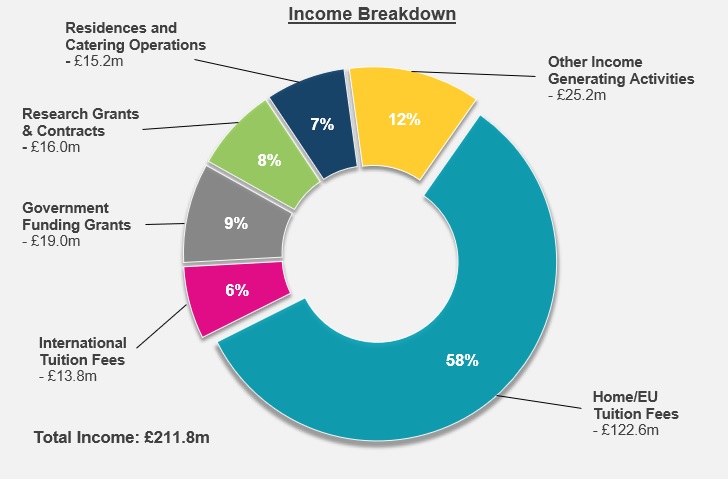What are the main income sources of the University and what do they get spent on?
Income
The University has a diverse range of income sources which are shown on the graph to the right (2020/21 Financial year), with total income increasing 21.4% compared to 2019/20, by £37.4m.
The University has a diverse range of income sources which are shown on the graph to the right (2020/21 Financial year), with total income increasing 21.4% compared to 2019/20, by £37.4m.
The main sources includes: tuition fees, government grants, commercial activity (residences, catering and conferencing) and research income. Other income generating activities comprises of consultancy work, investment income and donations.
Expenditure (Costs)
Students have always been our core focus, from the graph you can see that Teaching and Supporting Academic Services makes up over half of the total expenditure (53%). There are also a number of costs involved in the running of the University which directly relate to students, these include: Bursaries, Student Support/Wellbeing and Student Union Support. (7.4% or £14.0m)
As well as the Library and ICT there are a number of other departments that support the quality of teaching at the University; while they are not all student facing, they have a key focus on ensuring we continue to deliver to a high standard. These departments make up the section ‘Other Departments Supporting Academic Services’, totalling £10.5m.
The University’s second largest cost is the maintenance of the buildings and facilities which are used by students and staff. The costs incurred in keeping our facilities well maintained to a high standard all adds to the quality of the student experience.
How is my £9,250 fee spent?
We believe it’s important to be transparent about where your tuition fee is spent, how it supports you whilst at Lincoln and ultimately, how it adds to a greater student experience.
As mentioned above, the University receives income from various sources, not all of which relates to students (e.g. Research income / costs), therefore the categories in this section differ slightly from the previous graphs. The breakdown below offers more insight into how a typical fee is spent.
Teaching
The cost of teaching students represents the highest proportion of the £9,250 fee and ensures we are able to deliver high quality undergraduate programmes. This category is primarily made up of expenditure on academic staff, as well as the costs within each School, such as teaching materials.
Academic Support
This section makes up the second largest cost and includes all expenditure which supports the learning experience of our students. It is predominantly made up of the University’s Library and ICT costs, but also includes spend on maintaining high academic standards of courses and teaching.
Student Support and Wellbeing
Our student support department offer a wide range of services to students, including: support for disabilities, financial support, health and welfare and much more. This category also includes bursaries/scholarships offered to students, support to the Students Union and costs associated with our careers and employability services.
For more information on our student support services, please visit https://studentservices.lincoln.ac.uk/
Buildings and Facilities
Expenditure relating to the running and maintaining of the buildings around campus, which includes seminar rooms, lecture theatres and our teaching laboratories. An element of this is for the campus services we offer, such as the Sports Centre and our Catering outlets.
Other Running Costs
The other general running costs of the University are mainly made up of supporting departments such as: HR, Finance, Marketing, Planning and other smaller areas.
To display this information in PDF format please use the link here



